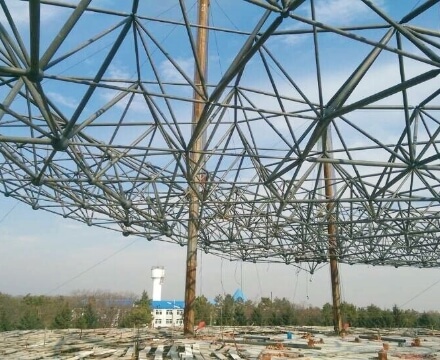Dapeng Town Industrial Park, Tongshan District, Xuzhou City, Jiangsu Province, China
The core and foundation of an effective space frame engineering budget can often be summed up in the question: What results do we hope to achieve from these important areas of activity? A space frame engineering budget should not be a simple extrapolation of the future from Businesses that make simple extrapolations of the past run into trouble sooner or later. The space frame engineering budget is necessarily a statement of future intent.
The space frame engineering budget is a tool that makes everything crystal clear, connects these things—including long-term planning, blueprints, strategy, creativity and innovation—into a whole and summarizes them, while Eliminate extraneous factors from the enterprise, and reallocate resources, and so on. Every effort must be guided by the following question: What steps do we take next to achieve these intentions?

People often use currency units to formulate space frame project budgets, and its form of expression is currency, which leads to some widespread erroneous views.
We should only consider the amount of funds as a “shorthand form” of the actual amount, so as long as the actual amount does not change, the adjustment of the amount of funds will not have any impact on the results.
A good financial engineering budget requires us to consider the expected results and necessary methodological measures comprehensively, meticulously and responsibly.
If the space frame engineering budget is viewed only as a cost control tool, it is unlikely to be effective. Most employees will find it irrational and bureaucratic, and it can even degenerate into a hindrance. Its more important function is to analyze the source and cause of costs, detail expenditure and the control of resource use and organizational priorities mentioned above.
In order to reduce the risky, naive extrapolation of the past into the future in its process, and force the employees to consider all activities carefully, it is necessary to budget space frame processing projects from scratch for a certain field of activity from time to time, It frees us from previous constraints, conventions, and conditions.
Although this work is time-consuming and difficult, it is well worth doing. Therefore, we should often selectively use zero-based space frame engineering budgets, not covering every activity in every year, but only once for each activity over a longer time interval. More importantly, this approach should continue to be used for space frame engineering budgeting for make-or-break activities.
It usually takes 12 months as a cycle, which is very necessary and reasonable in principle. However, not all work can be compressed into 12 months. If you try to do this, you run the risk of severing the natural and logical connections between things. If a space frame project budget is to be completed over multiple cycles, then the multi-period rolling space frame project budget should be an improvement on the 12-month fixed cycle. However, no matter how a rolling space frame project budget is prepared, we are subject to an artificial and (largely) arbitrary periodization.
The main cause of massive cost overruns is not lack of discipline, unbridled waste, lax or lax controls, but failure to take into account the subsequent costs of the project. This is why people find themselves suddenly deep in the money quagmire. Once we make a decision, it is up to us to bear the consequences. This is one of the main reasons why supervisory boards and boards of directors are often unsuccessful in approving budgets for space frame projects. We had no say in the matter and were forced to accept what came with it.
Of course, errors can occur, as space frame engineering budgets must be based on various assumptions. However, this kind of engineering budget forces us to think hard about the various aspects involved in a different, more practical way than just doing the space frame engineering budget for the next 12 months.
In general, we should always take as a guide the following assumption: that a great deal of cost is spent not on failed projects, but on successful ones because they incur high follow-up costs. Therefore, we have to be especially prepared for the follow-up costs of success. Project failure does kill the business. However, those companies that have experienced success but have gone bankrupt because they cannot afford the cost of success are even more tragic.
Closely related to the above, we often find that organizations actually need two different space frame engineering budgets. They serve completely different goals and, accordingly, have completely different levels of difficulty in formulating them.
(1) A space frame project budget is a standard space frame project budget, that is, a business space frame project budget. This kind of engineering budget is aimed at the current existing business, which is the business we know and are familiar with. In this kind of engineering budget, although we cannot make future extrapolation based on the past alone, past and present data are useful, at least partially reliable reference data. The key question involved in this kind of engineering budget is: What is the minimum amount of resources required to successfully maintain commercial operations? In this kind of engineering budget, the traditional enterprise management thinking method is applicable and correct.
(2) The second type of space frame project budget is the opportunity space frame project budget. Sadly, only a very small number of enterprising companies make it, and this kind of engineering budget is aimed at something new, that is, innovation.